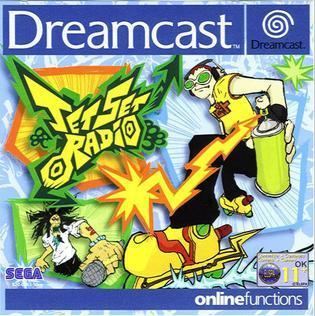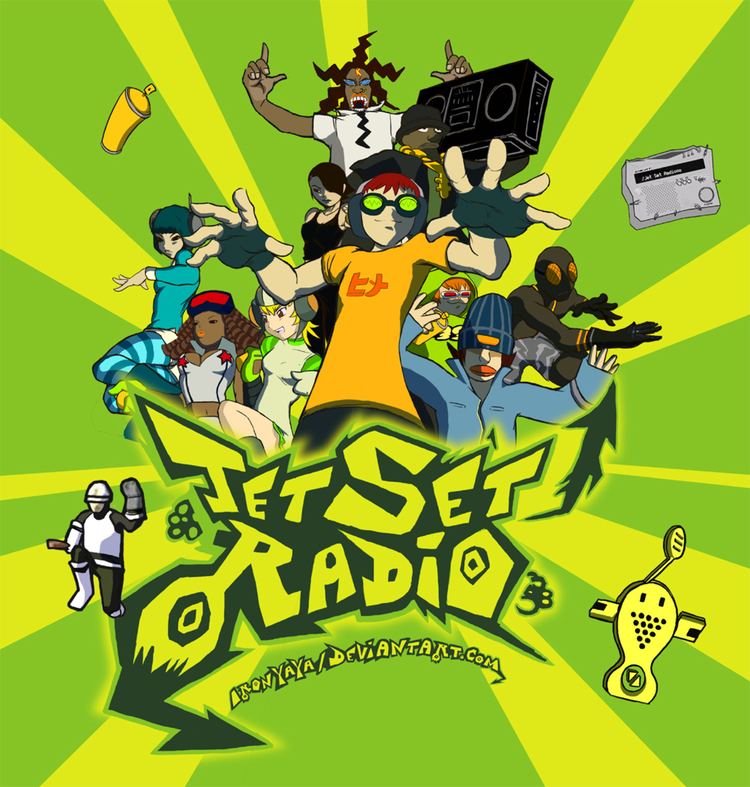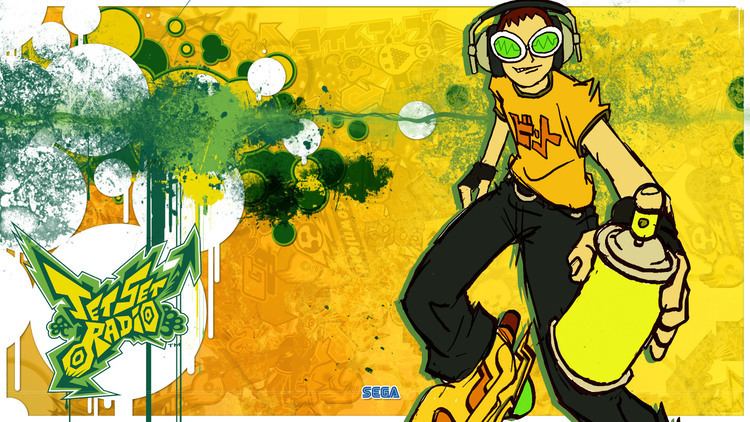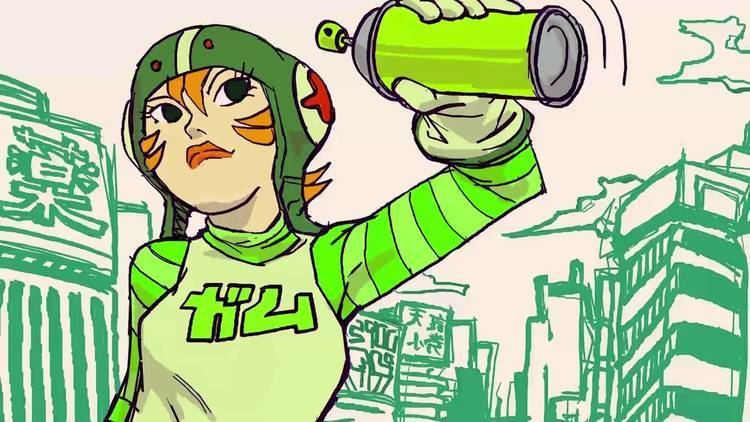7 /10 1 Votes
4.5/10 GameSpot Publisher(s) SegaTHQ (GBA) Producer(s) Osamu Sato Initial release date 29 June 2000 | 9/10 Steam 7.5/10 IGN Director(s) Masayoshi Kikuchi Series Jet Set Radio | |||||||||||||||||||||||||||||||||
 | ||||||||||||||||||||||||||||||||||
Release date(s) DreamcastJP: June 29, 2000NA: October 30, 2000EU: November 24, 2000Java MEJP: June 22, 2001Game Boy AdvanceNA: June 26, 2003EU: February 20, 2004PlayStation 3NA: September 18, 2012EU: September 19, 2012JP: February 20, 2013SteamWW: September 19, 2012Xbox 360NA: September 19, 2012EU: September 19, 2012JP: February 20, 2013PlayStation VitaNA: November 20, 2012EU: November 21, 2012JP: February 20, 2013iOSWW: November 29, 2012JP: December 20, 2012AndroidWW: November 29, 2012JP: January 30, 2013 Similar Sega games, Platform games | ||||||||||||||||||||||||||||||||||
Jet set radio hd pc gameplay
Jet Set Radio (ジェットセットラジオ, Jetto Setto Rajio), titled Jet Grind Radio on the first North American release, is an action game developed by the Sega studio Smilebit. It was published by Sega for the Dreamcast on June 29, 2000 in Japan, October 30, 2000 in North America, and November 24, 2000 in Europe. The player controls one of a gang of youths who roam the streets of Tokyo-to, rollerblading and spraying graffiti while evading the authorities. It was one of the first games to use cel-shaded visuals, giving it a "flat", cartoon-like appearance.
Contents
- Jet set radio hd pc gameplay
- Ps3 longplay 032 jet set radio hd
- Gameplay
- Visual style
- Development
- Plot
- Soundtrack
- Release
- Game Boy Advance version
- Typing Jet
- De La Jet Set Radio
- HD port
- Reception
- Awards
- Legacy
- Jet Set Radio Future
- Appearances in other games
- References

A version by Vicarious Visions was released by THQ for Game Boy Advance on June 26, 2003 in North America and February 20, 2004 in Europe. A sequel, Jet Set Radio Future, was released in 2002 for the Xbox. A high-definition port, developed by Blit Software, was released for Xbox Live Arcade, PlayStation Network and Windows in September 2012, and for PlayStation Vita, as well as iOS and Android at later points.

Ps3 longplay 032 jet set radio hd
Gameplay

The player controls Beat, a tagger who forms a gang of graffiti-tagging rollerbladers. In a typical stage, the player must tag every graffiti spot in each area before the timer runs out, while evading the authorities, who pursue on foot, in tanks and in helicopters. New playable characters are unlocked after the player beats them in trick battles.

The game is controlled with only a few buttons, and technical aspects of skating are simplified compared to games such as Tony Hawk's Pro Skater. According to Vice, although Jet Set Radio is "about the fluidity of good skating, the joy of motion and skill ... skating is less the focus and more the medium"; the game instead emphasizes a "general sense of youthful rebellion".
Visual style
Jet Set Radio was one of the first games to feature cel-shaded graphics, with exaggerated shapes, thick lines, and flat, bright colors. According to Vice, "The whole world feels like it could be scrawled on a wall somewhere, reeking of spray paint fumes."
Development
Jet Set Radio was conceived by Ryuta Ueda, who joined Sega in 1995. He wanted to make a game with a character and style that were inherently "Sega-like". An observation of Parappa the Rapper in 1996 and strong anime and manga culture in Japan also influenced the decision to utilize the game's cel-shaded style. During 1998, after development of Panzer Dragoon Saga was finished, the opportunity came to develop the game. It was made in complete contrast to Panzer Dragoon, something dealing with popculture. The team was young with only the producer being in his thirties. The game had no set genre or gameplay style throughout its development, however it was settled at the end that the game should be simple to play.
Jet Set Radio was announced at the 1999 Tokyo Game Show and drew media attention for its cel-shaded style. Now commonplace in game design, cel-shading allows for a "cartoon-like" appearance of 3D rendered objects. The graffiti featured in the game was the work of a variety of artists. Eric Haze, a graffiti artist who designed album art for acts including the Beastie Boys and Public Enemy, provided a number of pieces used in the game by the player, the game's logo, and other incidental art. Other graffiti contributors include Edge, Uecho, Enas, Higuchin, Chikpon, and K-Chap.
The localized version with two additional levels inspired by American locals were made reluctantly by the developers, due to Ryuta Ueda feeling that the game perfectly captured the Japanese spirit at that period of time.
Plot
Professor K, DJ of the Jet Set Radio pirate radio station, broadcasts to gangs of youths who roam the streets of Tokyo-to, rollerblading and spraying graffiti.
One skater, Beat, forms a new gang, the GGs, with skaters Gum and Tab. They compete with rival gangs for turf: the all-female Love Shockers in the shopping districts of Shibuya-Cho; the cyborg Noise Tanks in Benten, an entertainment district; and the kaiju Poison Jam in the Kogane dockyard. The authorities, led by Captain Onishima, mount a counter-offensive, deploying riot police, tanks, and helicopters.
The GGs are joined by skaters Combo and Cube, who explain that their hometown, Grind City, has been overtaken by the Rokkaku, a sinister conglomerate. The GGs confront the Rokkaku CEO, Goji Rokkaku, atop the Rokkaku building, a giant turntable. Goji has recovered The Devil's Contract, a vinyl record which reportedly has the power to summon demons, which he plans to use to conquer the world. The GGs tag him with graffiti and he falls to his death.
Freedom is returned to the streets of Tokyo-to. Combo reveals that the The Devil's Contract was simply "an old indie record" with no demonic powers, and that wealth had driven Goji to insanity.
Soundtrack
The Jet Set Radio soundtrack includes an eclectic array of original and licensed songs combining the musical genres of J-pop, hip hop, funk, electronic dance music, rock music, acid jazz, trip hop, and in the North American version, metal. All but three of the tracks from the combined worldwide soundtrack have been kept in the HD port, with "Yappie Feet", "Dunny Boy Williamson Show" and "Many Styles" being omitted due to licensing issues. The Game Boy Advance versions features shorter samples of six of the game's songs.
Vice described the music as "energetic, rhythm-heavy and defiant ... an eclectic mixture of hip-hop, dance pop, ska, and Japanese rock, a multicultural melange of youth culture and an irrepressible, joyful sense of revolution. Every moment thrums to its soundtrack, which is, on the default settings, emphasized almost more than the in-game sounds, positioning it as a central consideration of play."
Release
Jet Set Radio was released in Japan on June 29, 2000. The U.S. release, re-titled Jet Grind Radio because of trademark issues, contained two new maps, various new songs, and other in-game content designed to increase the game's appeal to western audiences. This version also allowed the user to connect to the Internet via SegaNet and download user-created graffiti tags, or upload tags of their own, as some could also be used to promote other Sega games.
Sales of the game were relatively low, but it has gone on to achieve a cult following in the gaming community.
Game Boy Advance version
A version of Jet Set Radio was released for the Game Boy Advance system in 2003, created by Vicarious Visions, the developers of the numerous Tony Hawk Pro Skater GBA games; and published by THQ. It featured an isometric perspective similar to the GBA Tony Hawk games and, despite the hardware limitations, cartoony graphics were designed to emulate the look of cel-shaded graphics, despite the smaller resolution. Music is reduced to 30 to 45 second samples. The levels ranged from exact duplicates to reminiscent counterparts of the original Jet Set Radio.
Typing Jet
A version for mobile phones, Typing Jet, was released in 2001 exclusively in Japan.
De La Jet Set Radio
After the public reported several bugs in the original Japanese version of Jet Set Radio, Sega decided to re-release it under the name of De La Jet Set Radio ("Deluxe" Jet Set Radio). This version was only sold in Japan via Dreamcast Direct (later renamed Sega Direct) making it one of the more rare Dreamcast titles available. The gameplay in this version was easier to pick up and included the added music from the PAL and North American versions, including the two levels only included in these two versions. The text featured in the game is localized in the main language of the player's Dreamcast, unlike the original Japanese version, which means that if the player's Dreamcast system is set to English language, the text in the game will be in English. The same goes for Japanese, German, French and Spanish. However, the voices remain Japanese in this version regardless of what language the Dreamcast is set to.
HD port
A high-definition port of Jet Set Radio was released for PlayStation 3 on September 18, 2012 (members of PlayStation Plus could purchase the game from September 11, 2012), on Xbox Live Arcade and Microsoft Windows on September 19, 2012, PlayStation Vita on November 20, 2012, and November 29, 2012 for iOS and Android devices. To promote the port, Sega ran a contest to allow players to submit their own artwork to be used as graffiti within the game. New features include widescreen HD graphics, online leaderboards, achievements, and a new camera system.The rerelease combines the North American, European and Japanese soundtracks, but omits the tracks "Yappie Feet" and "Many Styles".
Reception
The game received positive reviews. Many praised the style of the game as the matching soundtrack with up-tempo music. Critics also applauded the simple arcade-style gameplay. Famitsu magazine scored the Dreamcast version of the game a 32 out of 40. The lowest review according to Game Rankings was a 3.5 out of 5 from Independent Gamer. IGN gave the game a 9.6 rating but criticized the camera control, saying, "You'll spend at least a week wondering why all games don't look this good. Then you will spend at least a month wondering why the camera didn't get fixed during localization." Eurogamer scored the HD version 9/10, writing that "The skating's still great, the city's still a joy to explore, and the soundtrack's still one of the very best ever put together." GamesRadar gave the HD version a 4/5, stating "Its varied missions will keep you coming back for more and the added treat of hearing its eclectic soundtrack makes playing them all the more fun."
In 2009, an early antagonist in the game, Captain Onishima, was ranked 95th in IGN's "Top 100 Videogame Villains" list.
IGN gave the Game Boy Advance version a score of 8.6. Official Nintendo Magazine gave it 76%, praising the game for "being faithful to the original".
Awards
Legacy
in 2012, Whatculture wrote that "Jet Set Radio is symbolic of a time in which Sega took more risks than anyone else in the industry", citing Shenmue and Crazy Taxi as other innovative Dreamcast games. Reviewing the 2012 rerelease, Eurogamer wrote that it "retains the power to astonish and amaze and bedazzle and beguile" and is still "one of the most striking games you could play on a 360, or a PS3, or a PC."
Jet Set Radio Future
The sequel to Jet Set Radio, which is called Jet Set Radio Future was developed for the Xbox and released in Japan on February 22, 2002, in North America on February 25, 2002 (under the title JSRF: Jet Set Radio Future) and in Europe on March 14, 2002 as a launch game for the console. The game's style and cel-shaded graphics remained faithful to the original, although somewhat improved to take advantage of the Xbox hardware.
Appearances in other games
Two of Jet Set Radio's characters, Beat and Gum, are playable characters in the sports title Sega Superstars Tennis. A tennis court is based on the game, with other characters from the game watching the match. Beat also features as a playable character in Sonic & Sega All-Stars Racing, taking his looks from Jet Set Radio Future, where his All-Star move is speeding through the track on his skates, spraying graffiti on his foes. There are several race tracks based on the game as well. Beat and Gum also appear in Sonic & All-Stars Racing Transformed, but retain their designs from the original game; a stage based on Jet Set Radio is included, as well as a returning JSRF track from the original game. Two of the songs from Jet Set Radio Future, "The Concept of Love" and "Teknopathic", were remixed for the arcade game Ollie King, which was also developed by the Jet Set Radio team and features a similar aesthetic. Goji Rokkaku makes a cameo in Yakuza. The world of Jet Set Radio also features prominently in the tenth episode of Hi sCoool! SeHa Girls.
